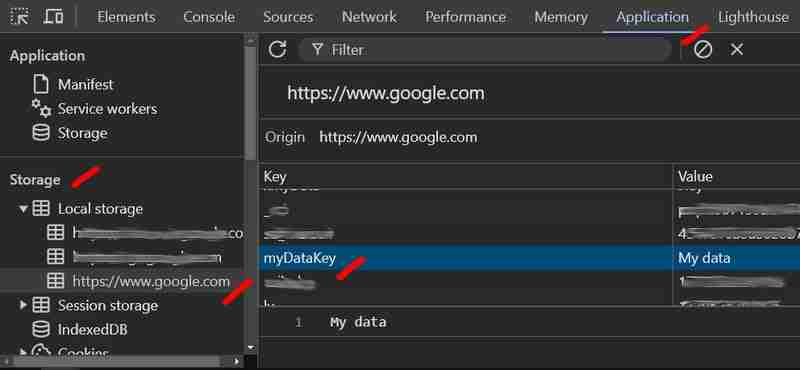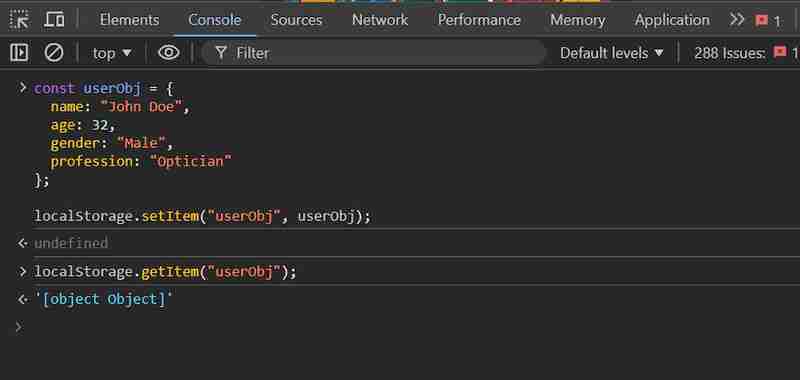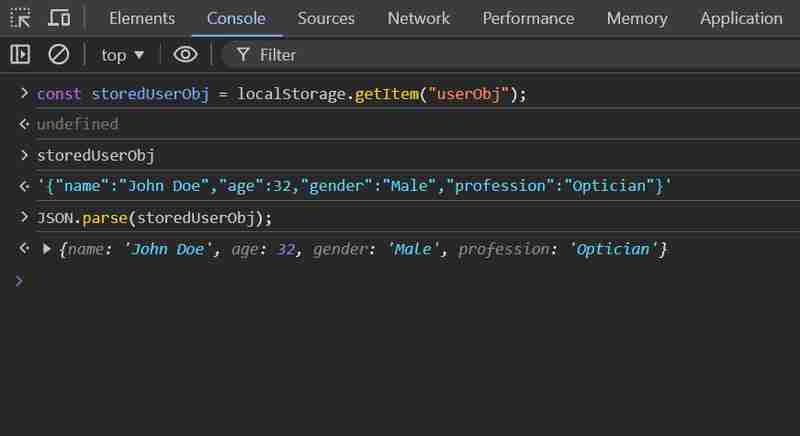在 localStorage 中存储和检索 JavaScript 对象
Written by Nelson Michael✏️
Editor’s note: This article was last updated by Rahul Chhodde on 7 August 2024 to offer a deeper exploration of storing objects in localStorage, such as techniques to serialize JavaScript objects using JSON.stringify, and situations where working with and storing multiple objects in localStorage is necessary.
The Web Storage API provides JavaScript-based mechanisms to securely store and access data as key-value pairs in the client's browser. This is useful for storing non-sensitive data such as user preferences, application states, and even API responses in some cases.
The two mechanisms of the Web Storage API, localStorage and sessionStorage, allow developers to store data persistently and temporarily. This stored data can be easily retrieved later and utilized to facilitate the user.
In this article, we'll learn how to stringify and parse JavaScript objects into JSON strings to save them in localStorage, and then reverse the process to retrieve the data. We'll also briefly cover the key differences between localStorage, sessionStorage, and HTTP cookies, highlighting the benefits and drawbacks of using localStorage over the other two.
What is localStorage?
The localStorage object is one of the two mechanisms of Web Storage that allow developers to store data on the client’s browser that persists even after the browser window is closed. This stored data can be accessed throughout a particular domain using easy-to-use API methods, some of which are shown below:
localStorage.setItem("myDataKey", "My data");
localStorage.getItem("myDataKey"); // "My data"
localStorage.removeItem("myDataKey");
Note that the data stored in the localStorage object from a domain can only be accessed or modified by pages of the same origin, which — in this case — stands for protocol, domain, and port collectively. You can verify this behavior using these methods in your browser’s developer console.
According to W3Schools, the localStorage object stores the data with no expiration date. The data will not be deleted even when the user leaves the page or closes the browser window; it will be available for future sessions. This ability to hold the data is known as data persistence in software and web development.
Using sessionStorage vs. localStorage
The second Web Storage mechanism, sessionStorage, is nearly identical to localStorage but differs in two ways: it temporarily stores data for the specified (or current) tab and does so for only a limited period.
The sessionStorage object stays active as long as the corresponding tab is open and persists data through page reloads and restorations. When a webpage is loaded into a browser tab, sessionStorage, if used, creates a new page session and assigns it to that tab. That page session is only valid for that particular origin accessed in that specific tab.
Note: Data stored in each kind of Web Storage is distinct for each protocol of a given page. This means that data stored on a site accessed via HTTP is stored on a different sessionStorage object than data stored on the same site accessed via HTTPS.
Key differences between sessionStorage and localStorage
localStorage and sessionStorage work similarly, but the main difference is that data stored in localStorage is persistent, shared between tabs of the same origin, and lasts forever for that specific origin unless the browser's storage is cleared or we clear localStorage using JavaScript or manually.
Using Chrome DevTools, you can view the data in both localStorage and sessionStorage objects and observe the distinctions we just covered. Here’s a screenshot depicting locating both objects in the Application tab of DevTools: 
To store and reuse information like user preferences, application states, API response, and larger chunks of data to facilitate perceived performance, we choose localStorage over sessionStorage, because this info should persist to be used occasionally to personalize and update the user experience.
Note: When the last private tab is closed, data stored in the localStorage object of a site opened in a private tab or incognito mode is cleared, which makes sense because it’s a private browsing session.
Web Storage vs. HTTP cookies
HTTP cookies are a conventional mechanism for storing small bits of data exchanged between the client and the server during each HTTP request.
Once connected to a client, the server generates certain bits of information, saves them in a cookie file, and sends them to the client’s browser. This information is labeled with a unique ID for each user and their computer, which helps the server identify the user whenever a connection is established.
Cookies carry information such as auth and session data, CSRF tokens, tracking data, and tiny, site-specific user preferences to help personalize a user's experience. However, they can be a privacy nightmare. We'll discuss this in the following segment.
Why and when to use cookies?
Cookies are not the recommended solution for storing larger volumes of data on the client side. They are better suited for session management and are one of the most widely supported solutions for doing so.
With each request, cookies are sent to the server in the HTTP headers from the browser, as opposed to using localStorage or sessionStorage, which are only accessed by the application as client-side data storage and open to vulnerabilities.
For session security, cookies marked as Secure and HttpOnly can minimize the chances of session hijacking, limiting XSS (cross-site scripting) and CSRF (cross-side request forgery) attacks on the user's browser during the session.
When not to use cookies
HTTP cookies have been a long-standing standard, and keeping your apps 100% cookie-free isn’t always possible. However, there are a few cases where you might want to avoid them:
- Cookies are supposed to be transmitted with every request made to the server, which is why they are kept tiny and can’t hold data more than 4KB. This makes them unfit for caching big values like huge user preference data, application states, user-authored documents, etc.
- Third-party cookies raise a serious privacy concern, as the site you’ve visited doesn’t create or own them. Such cookies are usually linked to tracking user data, which puts them under suspicion, and many browsers are preparing to restrict them to safeguard user privacy
These points leave us to store our heaps of non-sensitive data in localStorage. Such situations often demand saving complex data like JavaScript objects locally, which requires a slightly different approach.
How to store a JavaScript object in localStorage
Modern web apps often demand saving JavaScript objects locally to provide offline access, restore application state, or cache an API response for perceived performance benefits.
Note that such data shouldn’t carry sensitive information, as once stored in Web Storage, it becomes accessible to any JavaScript code running on the same origin.
Let's start by gaining a basic understanding of how to work with localStorage by exploring its methods and properties for various use cases:
- setItem(): Adds data to a Web Storage object using its two arguments, a key, and a value: localStorage.setItem("key", "value")
- getItem(): Returns the value of the key name that’s passed to it: localStorage.getItem("key")
- **removeItem()**: Removes a key that’s passed to it with its corresponding value: localStorage.removeItem("key")
- clear(): Clears all the key-value pairs in the associated storage and should be used with caution: localStorage.clear()
- **key()**: Returns the key at the specified index in the storage: localStorage.key(0)
- length: Returns the total number of key-value pairs stored in the associated storage: localStorage.length
You can learn more about these methods on MDN’s Web Storage API docs.
The example below demonstrates data persistence accomplished using some of these Web Storage API methods. Click the Current count button, rerun the CodePen, and see the count data persisting using localStorage:
See the Pen localStorage in action by Rahul (@_rahul) on CodePen.
In the demo above, whenever you click the count or the clear button, multiple localStorage items are created, read, or modified and the changes to the corresponding values are reflected in the frontend.
JavaScript object serialization
Storing JavaScript object data in Web Storage is a bit tricky, as it allows you to store only string values. If we try to store a JavaScript object without first converting it to a string, we will get an [object Object] response, as shown in the image below:
 [object Object] is a string representation of an object instance whose value was never read at the time of storing the data, which will result in data loss.
[object Object] is a string representation of an object instance whose value was never read at the time of storing the data, which will result in data loss.
The correct way to store object data to localStorage is to first convert it to a string. Then, we can move on to the storage procedure.
This object-to-string conversion of object data is known as serialization, and turning this converted string back to object data is called deserialization. Let’s briefly discuss two important JSON methods that are responsible for object data serialization and deserialization:
- JSON.stringify: Converts any object value into a string JSON (serialization)
- JSON.parse: Turns a JSON string into its corresponding object or value (deserialization)
Now, utilizing the setItem method with JSON stringify, we can easily convert a JavaScript object to a JSON string and push it to the localStorage object. Here’s a quick example to demonstrate this:
const userObj = {
name: "John Doe",
age: 32,
gender: "Male",
profession: "Optician"
};
localStorage.setItem("userObj", JSON.stringify(myObject));
Now, if we try to retrieve the object data without deserializing it, we will receive a JSON string instead of an object, which makes sense, as it is what we stored to localStorage.
We need to deserialize this JSON string data using the JSON parse method to turn it back into a JavaScript object:
let newObject = localStorage.getItem("myObject");
console.log(JSON.parse(newObject));
Here, we retrieved our previously set JavaScript object using the getItem method on the localStorage object and saved it into a variable. Next, we parsed that string into a JavaScript object and finally logged it to the console:

More examples of storing objects in localStorage
- Storing Date objects: Constructing an object using the current timestamp using the Date object and a random value, and saving it to or clearing it from the localStorage using button inputs
- Persisting remote data: Fetching remote data from a dummy API and storing it in localStorage; the network fetch in this example is only triggered when no associated data in localStorage is found
Storing multiple objects in localStorage
Let’s say we have a bunch of similar objects, and we want to group all of them and store them as one JSON string in the localStorage. We can turn them into an object array and then serialize them as shown below:
const todos = [todo1, todo2, todo3];
localStorage.setItem("todos", JSON.stringify(todos));
If you have bigger chunks of data to work with, you might want to store each of them with separate keys, but accessing all of them quickly can be done using this namespace approach:
// Storing
localStorage.setItem('todos:1', JSON.stringify(todo1));
localStorage.setItem('todos:2', JSON.stringify(todo2));
// Retrieving
const keys = Object.keys(localStorage).filter(key => key.startsWith('todos:'));
const todos = keys.map(key => JSON.parse(localStorage.getItem(key)));
Limitations of storing objects to localStorage
localStorage is one of the mechanisms of the Web Storage API. The API provides 5-10MB of storage per origin, and the exact storage may vary depending on the browser. Respecting this size limit, you should avoid storing more than 3-4MB of data per origin in Web Storage objects.
Keep in mind that Web Storage API operations are synchronous and block the main thread, therefore performing heavy operations using it may block other resources from loading in the browser.
Types of data that can be stored as a JSON string
Primitive data types like numbers, Booleans, and strings are JSON-safe, while values like functions, undefined, symbols, and Date objects are not JSON-safe. If no JSON-safe values are found during conversion, they are either excluded from an object or changed to null in an array.
Note: Some of these such values can be made JSON-safe, for example, we used the toISOstring method with the Date object in this example to make it JSON-safe before pushing it to Web Storage.
Conclusion
In this article, we learned a useful technique for storing multiple bits of information in a single localStorage key and using the JSON stringify and parse methods. We also covered some working demonstrations that apply this approach to different tasks, as well as storing and retrieving multiple JavaScript objects from localStorage.
In summary, we should be mindful of the data we store locally, and take advantage of the localStorage object to store JavaScript objects by first converting them to JSON strings with the JSON.stringify method and then turning them back to objects with the JSON.parse method.
LogRocket: Debug JavaScript errors more easily by understanding the context
Debugging code is always a tedious task. But the more you understand your errors, the easier it is to fix them.
LogRocket allows you to understand these errors in new and unique ways. Our frontend monitoring solution tracks user engagement with your JavaScript frontends to give you the ability to see exactly what the user did that led to an error.

LogRocket records console logs, page load times, stack traces, slow network requests/responses with headers bodies, browser metadata, and custom logs. Understanding the impact of your JavaScript code will never be easier!
Try it for free.
-
 我可以将加密从McRypt迁移到OpenSSL,并使用OpenSSL迁移MCRYPT加密数据?将我的加密库从mcrypt升级到openssl 问题:是否可以将我的加密库从McRypt升级到OpenSSL?如果是这样,如何?答案:是的,可以将您的Encryption库从McRypt升级到OpenSSL。可以使用openssl。附加说明: [openssl_decrypt()函数要求iv参...编程 发布于2025-04-06
我可以将加密从McRypt迁移到OpenSSL,并使用OpenSSL迁移MCRYPT加密数据?将我的加密库从mcrypt升级到openssl 问题:是否可以将我的加密库从McRypt升级到OpenSSL?如果是这样,如何?答案:是的,可以将您的Encryption库从McRypt升级到OpenSSL。可以使用openssl。附加说明: [openssl_decrypt()函数要求iv参...编程 发布于2025-04-06 -
 如何在GO编译器中自定义编译优化?在GO编译器中自定义编译优化 GO中的默认编译过程遵循特定的优化策略。 However, users may need to adjust these optimizations for specific requirements.Optimization Control in Go Compi...编程 发布于2025-04-06
如何在GO编译器中自定义编译优化?在GO编译器中自定义编译优化 GO中的默认编译过程遵循特定的优化策略。 However, users may need to adjust these optimizations for specific requirements.Optimization Control in Go Compi...编程 发布于2025-04-06 -
 如何有效地选择熊猫数据框中的列?在处理数据操作任务时,在Pandas DataFrames 中选择列时,选择特定列的必要条件是必要的。在Pandas中,选择列的各种选项。选项1:使用列名 如果已知列索引,请使用ILOC函数选择它们。请注意,python索引基于零。 df1 = df.iloc [:,0:2]#使用索引0和1 的 ...编程 发布于2025-04-06
如何有效地选择熊猫数据框中的列?在处理数据操作任务时,在Pandas DataFrames 中选择列时,选择特定列的必要条件是必要的。在Pandas中,选择列的各种选项。选项1:使用列名 如果已知列索引,请使用ILOC函数选择它们。请注意,python索引基于零。 df1 = df.iloc [:,0:2]#使用索引0和1 的 ...编程 发布于2025-04-06 -
 如何在Java的全屏独家模式下处理用户输入?Handling User Input in Full Screen Exclusive Mode in JavaIntroductionWhen running a Java application in full screen exclusive mode, the usual event ha...编程 发布于2025-04-06
如何在Java的全屏独家模式下处理用户输入?Handling User Input in Full Screen Exclusive Mode in JavaIntroductionWhen running a Java application in full screen exclusive mode, the usual event ha...编程 发布于2025-04-06 -
 哪种在JavaScript中声明多个变量的方法更可维护?在JavaScript中声明多个变量:探索两个方法在JavaScript中,开发人员经常遇到需要声明多个变量的需要。对此的两种常见方法是:在单独的行上声明每个变量: 当涉及性能时,这两种方法本质上都是等效的。但是,可维护性可能会有所不同。 第一个方法被认为更易于维护。每个声明都是其自己的语句,使其...编程 发布于2025-04-06
哪种在JavaScript中声明多个变量的方法更可维护?在JavaScript中声明多个变量:探索两个方法在JavaScript中,开发人员经常遇到需要声明多个变量的需要。对此的两种常见方法是:在单独的行上声明每个变量: 当涉及性能时,这两种方法本质上都是等效的。但是,可维护性可能会有所不同。 第一个方法被认为更易于维护。每个声明都是其自己的语句,使其...编程 发布于2025-04-06 -
 在GO中构造SQL查询时,如何安全地加入文本和值?在go中构造文本sql查询时,在go sql queries 中,在使用conting and contement和contement consem per时,尤其是在使用integer per当per当per时,per per per当per. [&&&&&&&&&&&&&&&&默元组方法在...编程 发布于2025-04-06
在GO中构造SQL查询时,如何安全地加入文本和值?在go中构造文本sql查询时,在go sql queries 中,在使用conting and contement和contement consem per时,尤其是在使用integer per当per当per时,per per per当per. [&&&&&&&&&&&&&&&&默元组方法在...编程 发布于2025-04-06 -
 如何在Java中执行命令提示命令,包括目录更改,包括目录更改?在java 通过Java通过Java运行命令命令可能很具有挑战性。尽管您可能会找到打开命令提示符的代码段,但他们通常缺乏更改目录并执行其他命令的能力。 solution:使用Java使用Java,使用processBuilder。这种方法允许您:启动一个过程,然后将其标准错误重定向到其标准输出。...编程 发布于2025-04-06
如何在Java中执行命令提示命令,包括目录更改,包括目录更改?在java 通过Java通过Java运行命令命令可能很具有挑战性。尽管您可能会找到打开命令提示符的代码段,但他们通常缺乏更改目录并执行其他命令的能力。 solution:使用Java使用Java,使用processBuilder。这种方法允许您:启动一个过程,然后将其标准错误重定向到其标准输出。...编程 发布于2025-04-06 -
 如何使用组在MySQL中旋转数据?在关系数据库中使用mySQL组使用mySQL组进行查询结果,在关系数据库中使用MySQL组,转移数据的数据是指重新排列的行和列的重排以增强数据可视化。在这里,我们面对一个共同的挑战:使用组的组将数据从基于行的基于列的转换为基于列。 Let's consider the following ...编程 发布于2025-04-06
如何使用组在MySQL中旋转数据?在关系数据库中使用mySQL组使用mySQL组进行查询结果,在关系数据库中使用MySQL组,转移数据的数据是指重新排列的行和列的重排以增强数据可视化。在这里,我们面对一个共同的挑战:使用组的组将数据从基于行的基于列的转换为基于列。 Let's consider the following ...编程 发布于2025-04-06 -
 如何使用FormData()处理多个文件上传?)处理多个文件输入时,通常需要处理多个文件上传时,通常是必要的。 The fd.append("fileToUpload[]", files[x]); method can be used for this purpose, allowing you to send multi...编程 发布于2025-04-06
如何使用FormData()处理多个文件上传?)处理多个文件输入时,通常需要处理多个文件上传时,通常是必要的。 The fd.append("fileToUpload[]", files[x]); method can be used for this purpose, allowing you to send multi...编程 发布于2025-04-06 -
 在Java中使用for-to-loop和迭代器进行收集遍历之间是否存在性能差异?For Each Loop vs. Iterator: Efficiency in Collection TraversalIntroductionWhen traversing a collection in Java, the choice arises between using a for-...编程 发布于2025-04-06
在Java中使用for-to-loop和迭代器进行收集遍历之间是否存在性能差异?For Each Loop vs. Iterator: Efficiency in Collection TraversalIntroductionWhen traversing a collection in Java, the choice arises between using a for-...编程 发布于2025-04-06 -
 eval()vs. ast.literal_eval():对于用户输入,哪个Python函数更安全?称量()和ast.literal_eval()中的Python Security 在使用用户输入时,必须优先确保安全性。强大的python功能eval()通常是作为潜在解决方案而出现的,但担心其潜在风险。本文深入研究了eval()和ast.literal_eval()之间的差异,突出显示其安全性含义...编程 发布于2025-04-06
eval()vs. ast.literal_eval():对于用户输入,哪个Python函数更安全?称量()和ast.literal_eval()中的Python Security 在使用用户输入时,必须优先确保安全性。强大的python功能eval()通常是作为潜在解决方案而出现的,但担心其潜在风险。本文深入研究了eval()和ast.literal_eval()之间的差异,突出显示其安全性含义...编程 发布于2025-04-06 -
 如何检查对象是否具有Python中的特定属性?方法来确定对象属性存在寻求一种方法来验证对象中特定属性的存在。考虑以下示例,其中尝试访问不确定属性会引起错误: >>> a = someClass() >>> A.property Trackback(最近的最新电话): 文件“ ”,第1行, AttributeError: SomeClass...编程 发布于2025-04-06
如何检查对象是否具有Python中的特定属性?方法来确定对象属性存在寻求一种方法来验证对象中特定属性的存在。考虑以下示例,其中尝试访问不确定属性会引起错误: >>> a = someClass() >>> A.property Trackback(最近的最新电话): 文件“ ”,第1行, AttributeError: SomeClass...编程 发布于2025-04-06 -
 可以在纯CS中将多个粘性元素彼此堆叠在一起吗?[2这里: https://webthemez.com/demo/sticky-multi-header-scroll/index.html </main> <section> { display:grid; grid-template-...编程 发布于2025-04-06
可以在纯CS中将多个粘性元素彼此堆叠在一起吗?[2这里: https://webthemez.com/demo/sticky-multi-header-scroll/index.html </main> <section> { display:grid; grid-template-...编程 发布于2025-04-06 -
 如何从PHP中的数组中提取随机元素?从阵列中的随机选择,可以轻松从数组中获取随机项目。考虑以下数组:; 从此数组中检索一个随机项目,利用array_rand( array_rand()函数从数组返回一个随机键。通过将$项目数组索引使用此键,我们可以从数组中访问一个随机元素。这种方法为选择随机项目提供了一种直接且可靠的方法。编程 发布于2025-04-06
如何从PHP中的数组中提取随机元素?从阵列中的随机选择,可以轻松从数组中获取随机项目。考虑以下数组:; 从此数组中检索一个随机项目,利用array_rand( array_rand()函数从数组返回一个随机键。通过将$项目数组索引使用此键,我们可以从数组中访问一个随机元素。这种方法为选择随机项目提供了一种直接且可靠的方法。编程 发布于2025-04-06 -
 为什么使用固定定位时,为什么具有100%网格板柱的网格超越身体?网格超过身体,用100%grid-template-columns 为什么在grid-template-colms中具有100%的显示器,当位置设置为设置的位置时,grid-template-colly修复了?问题: 考虑以下CSS和html: class =“ snippet-code”> g...编程 发布于2025-04-06
为什么使用固定定位时,为什么具有100%网格板柱的网格超越身体?网格超过身体,用100%grid-template-columns 为什么在grid-template-colms中具有100%的显示器,当位置设置为设置的位置时,grid-template-colly修复了?问题: 考虑以下CSS和html: class =“ snippet-code”> g...编程 发布于2025-04-06
学习中文
- 1 走路用中文怎么说?走路中文发音,走路中文学习
- 2 坐飞机用中文怎么说?坐飞机中文发音,坐飞机中文学习
- 3 坐火车用中文怎么说?坐火车中文发音,坐火车中文学习
- 4 坐车用中文怎么说?坐车中文发音,坐车中文学习
- 5 开车用中文怎么说?开车中文发音,开车中文学习
- 6 游泳用中文怎么说?游泳中文发音,游泳中文学习
- 7 骑自行车用中文怎么说?骑自行车中文发音,骑自行车中文学习
- 8 你好用中文怎么说?你好中文发音,你好中文学习
- 9 谢谢用中文怎么说?谢谢中文发音,谢谢中文学习
- 10 How to say goodbye in Chinese? 再见Chinese pronunciation, 再见Chinese learning

























